InterviewSolution
This section includes InterviewSolutions, each offering curated multiple-choice questions to sharpen your knowledge and support exam preparation. Choose a topic below to get started.
| 89101. |
i) Write IUPAC name of CH_(3)CH_(2)NH_(2). ii) Arrange the following amines in the order of their increasing basic strength in aqueous solution. (CH_(3))_(3)N_(1), (CH_(3))_(2)NH_(1), CH_(3)NH_(2). |
|
Answer» Solution :(a) When amide is heated with bromine and SODIUM hydroxide , `1^(0)` - amine is formed. `R-Co-NH_2+Br_2+4NaOH(aq) overset(Delta)(rarr)R - NH_2 + Na_2CO_3 + 2NaBr + 2H_2O` (B) (i) ETHANAMINE (ii) `(CH_3)_(3)N < CH_3NH_2 < (CH_3)_(2)NH` (C ) `C_6H_5N_(2)^(+)Ci^(-) + NaCl + 2H_2O` |
|
| 89102. |
(a) How many you account for the following : (i) Aldehydes are more reactive than ketones towards nucleophiles. (ii) The boiling points of aldehydes and ketones are lower than of the corresponding acids. (iii) The aldehydes and ketones undergo a number of addition reactions. (b) How will you distinguish between these compounds: (i) Acetaldehyde and benzaldehyde (ii) Propanone and propanol |
|
Answer» Solution :(a) (i) Due to smaller + I -effect of one alkyl group in aldehydes as compared to larger +I-effect of two alkyl groups, the MAGNITUDE of positive charge on the carbonyl carbon is more in aldehydes than in ketones. As a result nucleophilic addition reaction occur more readily in aldehyde than in Ketones. (ii) The boiling points of aldhydes and ketones are lower than corresponding acids and alcohols due to absence of intermolecular hydrogen bonding. (iii) Aldehydes and Ketones undergo a number of addition reactions as both possess the carbonyl FUNCTIONAL group which reacts a number of nucleophiles such as HCN, `NaHSO_(3)`, alcohols, ammonia derivatives and Grignard reagents. (b) (i) Distinction between acetaldehyde and benzaldehyde : Acetaldehyde and benzaldehyde can be DISTINGUISH by Fehling solution. Acetaldehyde give RED coloured precipitate with Fehling solution while benzaldehyde does not. `CH_(3)CHO+underset("Fehling solution")ubrace(2Cu^(2+)5OH^(-))rarrunderset("red ppt.")(CH_(3)COO^(-))+Cu_(2)O+H_(2)O` (ii) Distinction between Propanone and Propanol : Propanone `(CH_(3)COCH_(3))` and propanol `(CH_(3)CH_(2)CH_(2)OH)` can be distinguish by iodoform test. Propanone when warmed with sodium hypoiodide (NAOI) i.e. `I_(2)` in NaOH, it gives yellow ppt of idoform while propanol does not respond to iodoform test. `underset("Propanone")(CH_(3)COCH_(3))+3NaOI rarr underset(" Yellow ppt")(CH_(3)Idarr+)CH_(3)COONa + 2NaOH` |
|
| 89103. |
A large increase in the rate of a reaction for a rise in temperature is due to |
|
Answer» INCREASE in the number of collisions |
|
| 89104. |
(a) How primary amine is prepared by Hoffmann bromamide degradation reaction? Write equation. ( b) (i) Write IUPAC name of CH_(3)CH_(2)NH_(2). |
|
Answer» Solution :Iioffmann.s Bromamide reaction : When an acid amide is heated with bromine and potassium hydroxide solution, a primary AMINE is obtained <BR> `R-COHN_(2)+Br_(2)+4KOH underset to triangle R-NH_(2)+K_(2) Co_(3)+2KBr+2H_(2)O and R=CH_(3)`. ( b )(i) Ethanamine (ii) `(CH_(3))_(2) NltCH_(3)NH_(2)lt(CH_(3))_(2)NH`. ( C ) `C_(6)H_(5)NII_(2)+NaNo_(2)+2IICI underset to (279-278K) C_(6)H_(5)N_(2)^(+)Cl^(-)+NaCl+2H_(2)O` |
|
| 89105. |
a.How many conformational isomers are possible of 4-isopropyl cylohexan-1,2-diols (I) ? b.Which isomers of (I) cannot form intramolecular H-bonding ? c.Which conformational isomer of cis-cyclohexan-1,3-diol forms intramolecular H-bonding ? d.Which conformational isomer of cis-cyclohexan-1,4-diol forms intramonal H-bonding ? |
Answer» Solution :a.For conformational isomers are possible. BULKY isopropyl group in equatiorial (e) form is more STABLE  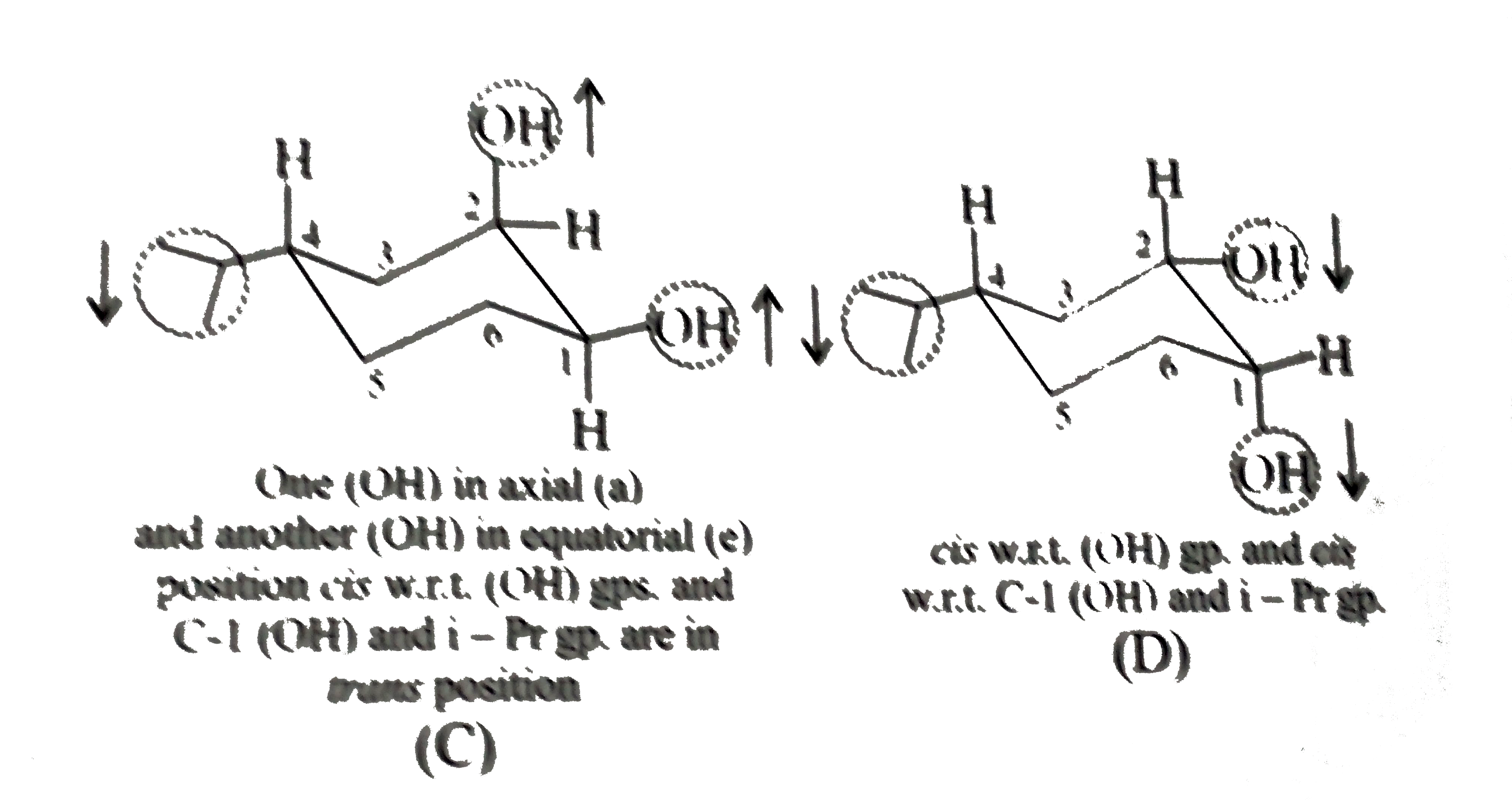 b.Isomer (A) cannot form H-bonding since two (OH) groups are position and POINT away form each other. Stability order is `B gt C = D gt A` . (Diequatorial form is more stable). c. 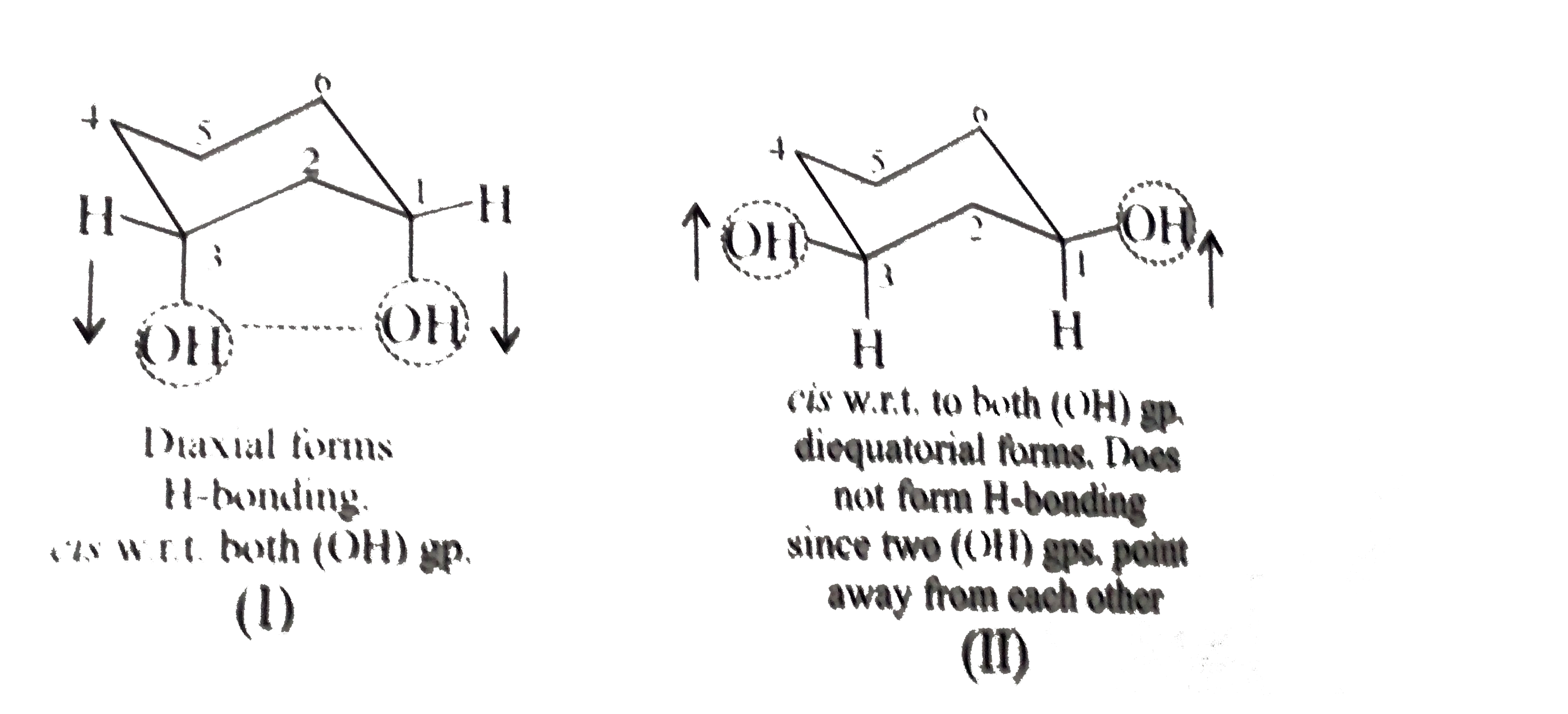 Although (I) is diaxial, it is more than diequatorial (II) due to H-bonding in (I). d.Diaxial boat form of cis-cyclohexan-1,4-diol forms H-bonding due to very CLOSE (1fp - 4fp) distance (183 pm) and thus is more stable. 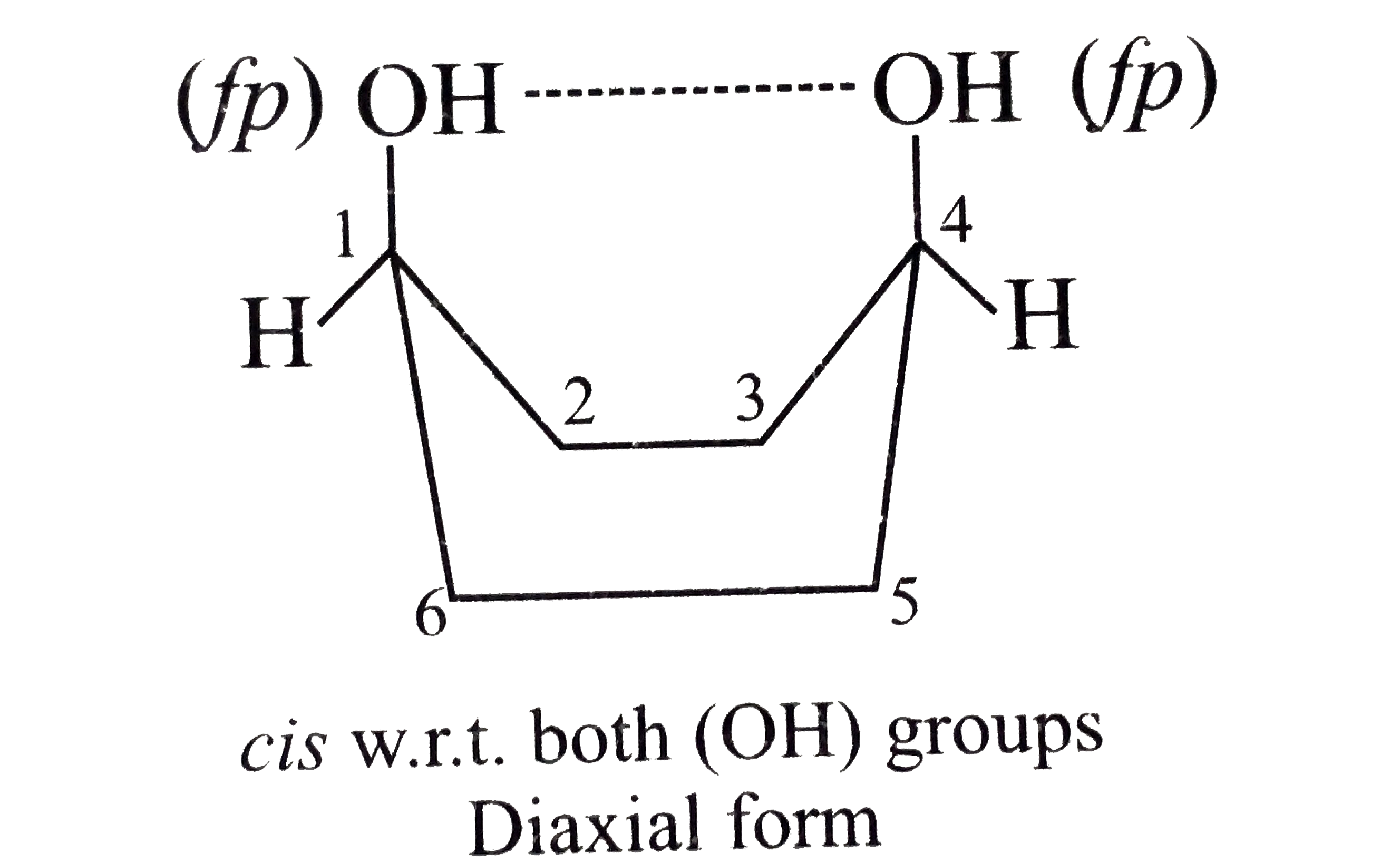 Although (I) daixial, it is more stable than diequatorial (II) due to H-bonding in (I). 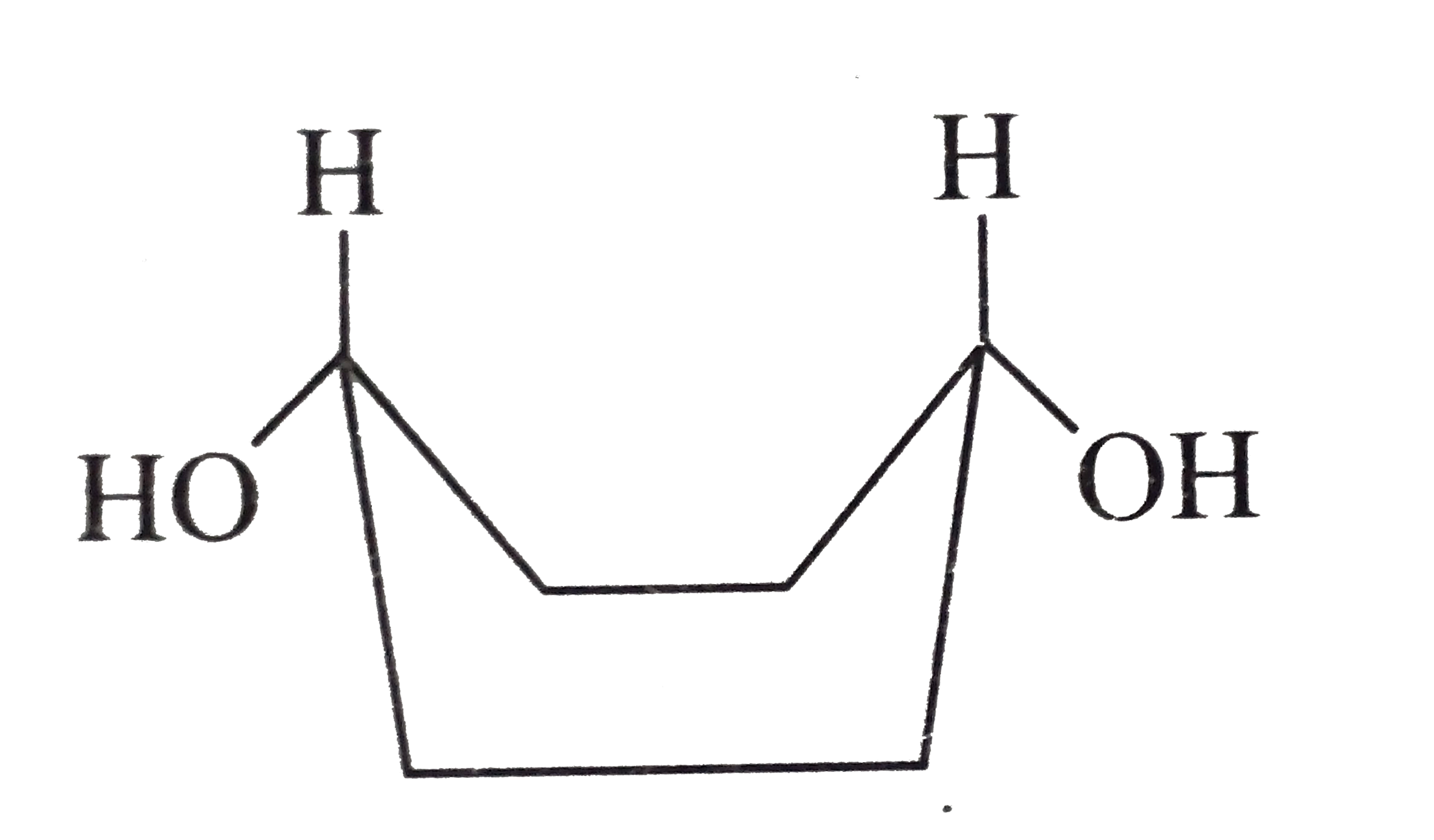
|
|
| 89106. |
a. How is the mixture of aspartic acid (A) histidine (B)and threonine(C ) separated by electrophoresis method? pI (pH at isoelectric point) are given. pI of (A),(B), and (C ) are 2.77,7.59, and 5.60 respectively. b. How are they separated by solubility method? |
|
Answer» Solution :a. Choose the intermediate `pH` of `5.60`. This is the `pI` of threoine, which has a zero net charge and does not migrate in the electric field or in the electrophoresis experiment. Aspartic ACID `(pI=2.77)` [Refer to solved Example No.8 `(d)` above] donates an `H^(o+)` and is converted to anion `(III)`, and migrates to the anode. histidine `(pI=7.59)` ACCEPTS an `H^(o+)` and is converted to a cation, and migrates to the CATHODE. b. At isoelectrical point `(pI)` the amino acids have least solubility in water and this property is exploited in the separation of different amino acids obtained from the hydrolysis of protein. To the MIXTURE of three amino acids `(A, B, and C)` set the `pH` of the solution by adding acid upto `2.77`, at which `(A)` will be least soluble in `H_(2)O` and will precipitate out. It is FOLLOWED by the separation of amino acid `(A)`. ltbRgt Increase the `pH` of the remaining solution by adding base upto `5.60`, at which amino acid `(C )` will precipate out. Similarly. `(B)` will precipate out at the `pH` of `7.59`. |
|
| 89107. |
(a) How is tehyl alcohol prepared from molasses ? (b) How is absolute alcohol obtained from rectified alcohol in the laboratory ? (c ) How is glycerol obtained on a large scale ? |
| Answer» | |
| 89108. |
(a) How is potassium dichromate prepared from chromite ? How does it react with : (i) acidified ferrous sulphate solution (ii) potassium iodide solution (iii) hydrochloric acid (iv) conc. H_(2)SO_(4) and soluble metal chloride ? (b) The orange colour of potassium dichromate changes to yellow on the addition of alkali, On acidifying the yellow solution, the colour again changes to Orange red. Explain giving equations. Draw structures of important species formed. |
|
Answer» Solution :(a) Potassium dichromate is prepared from chromite (`FeCr_(2),O_(4)`) by FUSING with molten alkali in the presence of air `FeCr_(2)O_(4)+ 16NaOH+ 7O_(2) to 8Na_(2)CrO_(4)+ 2Fe_(2)O_(3)+ 8H_(2)O` The solution of sodium chromate is filtered and acidified with dil , `H_(2)SO_(4)`giving sodium dichromate `2NaCrO_(4)+ 2H^(+) to Na_(2)Cr_(2)O_(7) + 2Na^(+)+ H_(2)O` Sodium dichromate is more soluble and less stable than potassium dichromate. Potassium dichromate is prepared by mixing a hot concentrated solution of`Na_(2)Cr_(2)O_(7)` and KCl in equimolar quantities. `Na_(2)Cr_(2)O_(7)+ 2KCI to K_(2)Cr_(2)O_(7) + 2NaCl` `K_(2)Cr_(2)O_(7)` is obtained as orange crystals, Reactions (1) `K_(2)Cr_(2)O_(7)`oxidises ferrous sulphate to ferric sulphate. `6FeSO_(4)+ K_(2)Cr_(2)O_(7)+ 7H_(2)SO_(4) to 3FeSO_(4)+ Cr_(2)(SO_(4))_(3)+ K_(2)SO_(4)+ 7H_(2)O` OR `Cr_(2)O_(7)^(2-)+ 6Fe^(2+)+ 14H^(+) to 2Cr^(3+)+ 7H_(2)O+ 6Fe^(3+)` (ii) `K_(2)Cr_(2)O_(7)+ 6KI+ 7H_2SO_(4)+ Cr_(2)(SO_(4))_(3)+ 7H_(2)O+ 3I_(2)` OR `Cr_(2)O_(7)^(2-)+ 6I^(-)+ 14H^(+) to 2Cr^(3+)+ 3I_(2)+ 7H_(2)O` (iii)`K_(2)Cr_(2)O_(7) + 14HCI to 2KCI+ 2CrCl_(3)+ 7H_(2)O+ 3Cl_(2)` (iv)`K_(2)Cr_(2)O_(7)+ 4NaCl+ 6H_(2)SO_(4) to 2KHSO_(4)+ 4NaHSO_(4)+ 2CrO_(2)Cl_(2)+ 3H_(2)O` (b)Potassium dichromate on heating with alkalies (KOH) changes to potassium chromate, which is YELLOW : `K_(2)Cr_(2)O_(7)+ 2KOH to underset("(Yellow)")(underset("Pot. chromate")(2K_(2)CrO_(4)))+ H_(2)O` On acidifying, the yellow colour change back to orange red due to reversible reaction. `2K_(2)CrO_(4) + H_(2)SO_(4) tounderset("(Orange)")(K_(2)Cr_(2)O_(7)) + K_(2)SO_(4) + H_(2)O` The two main species involved are `CrO_(4)^(2-)` and `Cr_(2)O_(7)^(2-)` IONS. Their structures are given below: 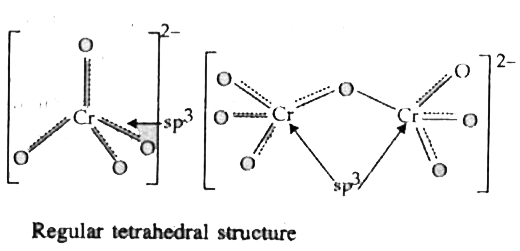 Regular tetrahedral structure |
|
| 89109. |
(a) How is phenol manufactured by cumene process. Give the chemical reactions of the reaction involved. (b) How do you prepare ethanol by using the Grignard Reagent? |
Answer» SOLUTION :
|
|
| 89110. |
A large increase in the rate of a reactant for a rise in temperature is due to ......... |
|
Answer» the decrease in the number of collisions |
|
| 89111. |
A large increase in the rate of a reaction for a rise in temerature is due to……. |
|
Answer» the decrease in the NUMBER of collisions |
|
| 89112. |
(a) How is nylon 6, 6 prepared? Give equation.(b) Write the partial structure of (i) Polythene(ii) Neoprene (c) Name the monomer present in natural rubber. |
Answer» Solution :(b) (i)  (ii) `underset("NEOPRENE")(CH_(2)-OVERSET(CL)overset(|)(C)=CH-CH_(2))` (c ) Isoperene (or) 2 - Methyl 1, 3 butadiene |
|
| 89113. |
A large increase in the rate of reaction for a rise in temperature is due to |
|
Answer» The DECREASE in the number of COLLISION |
|
| 89114. |
(a) How is ozonised oxygen prepared in the laboratory? Give equation.(b) Give the composition of " Oleum". |
|
Answer» SOLUTION :(a) Ozone is prepared by subjecting pure and dry Oxygen to SILENT electric discharge A sparkle electric discharge (silent) produce less HEAT. This prevent the local rise in temperature which may decompose ozone bact to oxygen. The apparatus used for the preparation of ozone is called ozonisers are commonly used,ie. sliemen.s ozoniser and Brodies ozoniser.The description of siemen.s ozoniser is being given below.br>siemen.s ozoniser it consists if two co axial tubrs at onr end. outer surface of the outer tubeand inner surface of the inner tube is called with tin foil.The inner and outer coating of tim foil are connected to thr terminals of induction coil. One end of the co-axial tube has inlet for pure and dry oxygen,and the other end has the outlet for ozonised oxygen.br> A slow stream of pure and dry oxygen is passed through the SPACE between the co-axial tubes and is subjected to the silent electrical discharge. Some of oxygen gets converted into ozone. The mixture containing 10-15% of ozone comes out of the outlet and is collected as such. (b) `H_2S_2O_2`. 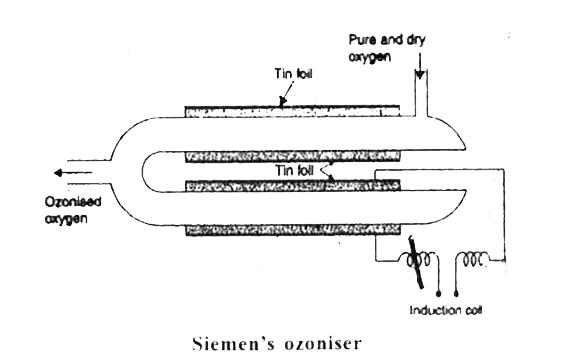
|
|
| 89115. |
A large increase in the rate of a reaction for a rise in temperature is due to : |
|
Answer» increase in the NUMBER of collisions |
|
| 89116. |
(a) How is methanamine prepared by Hoffmann bromamide degradation reaction? Give equation.(b) How is aniline converted to Benzene diazonium chloride? Give equation.(c) Between ammonia and aniline, which is more basic? |
|
Answer» Solution :(a) Hoffmann.s bromamide reaction: When an ACID amide is heated with bromine and potassium hydroxide solution, a primary amine is obtained. `R-CONH_(2) +Br_(2) + 4KOH overset(Delta)toR-NH_(2) +K_(2)CO_(3) +2KBr + 2H_(2)O and R = CH_(3)`. (b)When primary arylamine REACT with nitrous acid at low temperature (273 - 278 K) to give aromatic DIAZONIUM salts. This reaction is known as diazotisation. Nitrous acid being unstable is prepared in situ by the reaction of sodium nitrate and dilute mineral acid. (b)  ( c)Ammonia. |
|
| 89117. |
(a) How is Gold-sol prepared by Bredig’s-arc method? (b) What is Homogeneous catalysis? Give an example. |
Answer» Solution :(a) An electric arc is struck between electrodes of the METAL immersed in the dispersion MEDIUM. the heat produced vapourises the metal which condenses to form particles of colloidal size. (i) (i) + Electrodes An electric arc is struck between electrodes of the metal immersed in the dispersion medium. The heat produced vapourises the metal which condenses to form particles of colloidal size. (ii)At catalytic process in which reactant and the catalyst are in the same phase, then the process is called homogeneous catalysis. Example (1): OXIDATION of sulphur-di-oxide to sulphur trioxide. `2SO_(2)(g) + O_(2)(g)overset(NO(g))(to) 2SO_(3) (g)` NO is a catalyst. . Example (2) : Acid hydrolysis of methylacetate `CH_(3)COOCH_(3)(l) + H2O(l) overset(HCI(l))(to) CH_(3)COOH(aq) + CH_(3)OH(aq)` Example (3) : Acid hydrolysis of canesugar `CO(aq) + H_2O(l) overset(H^(+))(to) underset(G"lucose")(C_(6)H_(12)O_(6))(aq) + underset(F"ructos"E)(C_(6)H_(12)O_(6)(aq)`. (c)Entropy decreases. |
|
| 89118. |
A large increase in rate of reaction for a rise of tempeature is due to |
|
Answer» increase in number of MOLECULAR collisions. |
|
| 89119. |
(a) How is Buna-N prepared? Give equation(b) Name the monomers of Nylon-6, 6.(c) What are thermosetting polymers? |
| Answer» SOLUTION :(B)Adipic acid and HEXAMETHYLENE diamine. | |
| 89120. |
A large difference between the fourth and fifth ionization energies indicates the presence of: |
|
Answer» 5 VALENCE ELECTRONS in an atom |
|
| 89121. |
A large increase in rate constant with a small rise in temperature for a gaseous reactions is indicative of |
|
Answer» large number of collisions at higher temperature. |
|
| 89122. |
(a) How is benzoyl chloride converted into benzaldehyde? Name the reaction. (b) Write the chemical reaction for the reaction between dilute NaOH and acetaldehyde, mention the name of the product formed. |
Answer» Solution :BENZOYL chloride on hydrogenation in the presence of PD-`BaSO_(4)` forms BENZALDEHYDE.  NAME of the reaction is Rosenmund reaction. (b) `2CH_(3)CHO hArr underset("3-hydroxybutanal")(CH_(3)-overset(OH)overset(|)(C)H-CH_(2)CHO) underset(-H_(2)O)overset(Delta)to underset("But-2-enal")(CH_(3)-CH=CH-CHO)`. |
|
| 89123. |
A large cylinder for storing compressed gas has a volume of 1.5 f t^(3). If the gas is stored under a pressure of 150 atm at 300 K, how many moles of the gas cylinder ? (1 f t^(2) = 28.32 "litre") |
|
Answer» Solution :pV = nRT `n = (150 XX (1.5 xx 28.32))/(0.0821 xx 300)` `= 258.70` moles. (R = 0.0821 lit. atm/K/mole) Weight of oxygen = moles `xx` MOL. Weight `= 258.70 xx 32` =8278.40 g. |
|
| 89124. |
How is benzoyl chloride converted into benzaldehyde. Write the equation and name the reaction. |
Answer» Solution :BENZOYL chloride is hydrogenated over catalyst, palladium on barium sulphate, Benzaldehyde is formed. This reaction is calle Rosenmund reduction.  (b) Grignard reagent reacts with dry ice (solid `CO_(2)`) to form an addition product `RMgX + CO_(2) overset("Dry ether")rarr R-overset(O)overset(||)(C )-OMgX` Addition product which on acid bydrolysis GIVES CARBOXYLIC acid. `R-overset(O)overset(||)(C )-OMgX underset(H_(2)O)overset(H^(+))rarr RCOOH + Mg(OH)X` (c ) Complete the reaction  `CHX_(3) + RCOONa` (a) Conversion of benzoyl chloride into benzaldehyde : The reaction is called Rosenmund.s reduction. In this reaction `H_(2)(g)` is PASSED over benzoyl chloride using `Pd//BaSO_(4)` in boiling xylene.  (b) 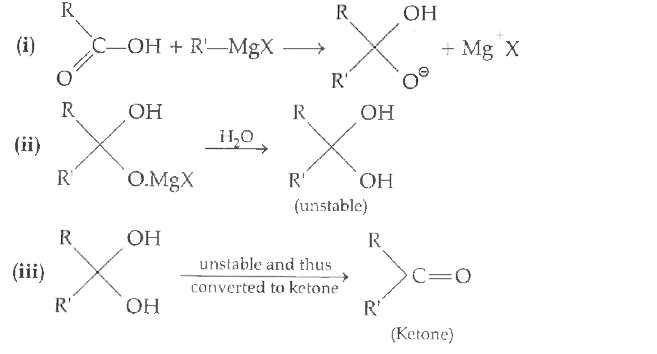 (c ) `underset("alkyl methyl ketone)")(R-underset(O)underset(||)(C)-CH_(3)) overset(NaOX)rarr underset("(Trihalo-ketone)")(R-underset(O)underset(||)(C)-C.X(3))+3NaOH` |
|
| 89125. |
A: Lanthanoids have +3 as most common oxidation state. B: Electrons of 4f in lanthanoids rarely participate |
|
Answer» If both Assertion & Reason are TRUE and the reason is the correct explanation of the assertion, then mark (1) |
|
| 89126. |
How does phosphorus react with limited amount of chlorine? Give equation. |
|
Answer» <P> Solution :(a) Phosphorus trichloride is prepared by passing DRY chlorine gas over WHITE phosphorus.`P_(4)+Cl_(2) to 4PCI_(3)` (b) When fluorine reacts with excess of bromine, bromine pentafluoride ` (BrF_(3))` is formed. |
|
| 89127. |
A large amount of …………….gas is released into atmosphere from plants used coal and oil and copper melting plants. |
| Answer» SOLUTION :`SO_(2)` | |
| 89128. |
(a) How does hot concentrated sodium hydroxide reacts with chlorine ? Write equation . (b) How does electronegativity of Halogens vary down the group ? |
|
Answer» Solution : Withhotand ConC NaOH chlorine GIVES chloride and CHLORATE `6NOH + 3CI _2`to `5NaCl+ NaClO_3 + 3H_2O` Electronegativity DECREASE down the group . `(F>CL>Br>I)` |
|
| 89129. |
A lanthanoid has 'n' unpaired electrons and another lanthanoid has (14-n) unpaired electrons. Itmeans generally :- |
|
Answer» Both LANTHANOID shows same COLOR |
|
| 89130. |
Answer any FOUR of the following questions. a. How does benzene reacts with acetyl-chloride in the presence of anhydrous AICI_3? Give equation. |
Answer» Solution :(a) (b) (i) `R-COOH+R^1- OH overset(H^+)( (C) Zinc AMALGAM and concentrated hydrochloric acid/Zn-Hg & Conc.HCI Detailed Answer: (a) This is an example of Friedel Craft.s acylation : One hydrogen from the benzene is REPLACED by the acetyl portion of the acetyl chloride, Hydrogen and chloride from the benzene and acetyl chloride RESPECTIVELY combine to form HCI. (b) Esterification: When ethanol reacts with acetic acid in the presence of an acid catalyst a sweet smelling ester is obtained. This REACTION is called Esterification. General equation for esterification is as follows: `R-COOH + R^1 - OH overset(H^+)( |
|
| 89131. |
A lake with an inflow of domestic sewage rich in organic waste may result in |
|
Answer» Drying of the LAKE very soon due to algal bloom |
|
| 89132. |
(a)How do you prepare : (i)K_(2)MnO_(4) from MnO_(2) (ii) Na_(2)Cr_(2)O_(7)from Na_(2)CrO_(4)? (b)Account for the following : (i) Mn^(2+) is more stable than Fe^(2+) towards oxidation to +3 state. (ii) The enthalpy of atomisation is lowest for Zn in 3d series of transition elements. (iii) Actinoid elementsshow widerange of oxidation states. or(i) Namethe elements of 3d transition series whichshows maximum number of oxidation states. Why dows itshow so ? (ii)Which transition element of 3d series has positiveE_(M^(+)//M)^(@) value and why ? (iii)Out of Cr^(3+) and Mn^(3+) which is stronger oxidizing agent and why ? (iv) Name a member of the lanthanoidseries which is well knownto exhibit +2oxidation state. (v)Complete the equation :MnO_(4)^(-) +8 H^(+) + 5e^(-) rarr |
|
Answer» Solution :(i) MN, (ii)Cu,(ii) `Mn^(3+)`,`(E_(M^(+)//Mn^(2+))^(@)= + 1.57V)` (iv)`EU^(2+)` due to exactly half FILLED `f^(7)` configurationand `Yb^(2+)` due to completely filled `f^(14)` configuration(v) `MnO_(4)^(-) +8 H^(+)+ 5e^(-) rarr Mn^(2+)4H_(2)O)` |
|
| 89134. |
(a) How does benzene reacts with acetyl- chloride in the presence of anhydrous AlCl_(3)? Give equation. (b) (i) Write general equation for esterification reaction. (ii) Name the product obtained when benzoic acid is heated with ammonia.(c) Name the reagent used in the Clemmensen reduction. |
Answer» Solution :(a)  (b)(i) `R - COOH + R . - OH overset(Conc.H_(2)SO_(4))TOR - COOR. + H_(2)O` (ii)Benzamide. (c)Zinc Amalgam [Zn/Hg] in Conc. HCL. |
|
| 89135. |
Consider an ideal gas contained in a vessel. It the intermolecular interaction suddenly begains to act, which of the following will happen : |
|
Answer» Place it in HOT strong nitric acid |
|
| 89136. |
(a) How do you convert the following: (i) Phenol to Anisole (ii) Ethanol to Propan-2-ol (b) Write mechanism of the following reaction: C_(2)H_(5)Ohunderset(443 K)overset(H_(2)SO_(4))toCH_(2)=CH_(2)+H_(2)O (c) Why phenol undergoes electrophilic substitution more easily than benzene? |
Answer» SOLUTION :(a) (i) Phenol to Anisole :  (ii) ETHANOL to Propan-2-ol:See Q. 18 (b), Paper 2013, Delhi Board, Set III, (Page 199] (b) Refer Q. 17 (), Paper-2018 (C), IPage 478]. (c) The rate of any ELECTROPHILIC substitution reaction depends UPON the density in the aromatic RING .Since the electron density is more in phenol than in benzene therefore, phenol undergoes electrophilie substitution more easily than benzene. |
|
| 89137. |
A lady's 18 carat gold wedding ring has become discoloured with some minutr drops of mercury from a broken thermometer. Which of the following treatments would restore it to its original condition : |
|
Answer» Place it in hot STRONG NITRIC ACID |
|
| 89138. |
(a) How can you prepare a buffer solution of pH 9. you are provided with 0.1 M NH_4 OH solutionand ammonium chloride crystals. (Given : pK_(b) for NH_4 OH is 4.7 at 25^@ C. |
|
Answer» SOLUTION :(a) `POH =pK_(b)+log.(["salt"])/(["base"])` We KNOW that `pH+pOH=14 ` `therefore 9+pOH=14` `RARR pOH=14-9=5` `5=4.7+log.([NH_4 CI])/([NH_4 OH])` `0.3 =log.([NH_4 CI])/(0.1)` `([NH_4 CI])/([0.1])` = antilog of `(0.3)` `[NH_4 CI]=0.1 M xx 1.995` `0.1995 M` `0.2 M` Amount of `NH_4 CI` required to prepare 1 litre 02 M solution = Strength of `NH_4 CI xx` molar mass of `NH_4 CI` `=0.2 xx 53.5` `10.70g` 10.70 g ammonium chloride is dissolved in water and the solution is made up to one litre of the given `NH_4 CI` solution and the prepared `NH_4 CI` solution will give a buffer solution with required pH VALUE `(pH=9)`. |
|
| 89139. |
a) How do you convert benzene diazonium chloride into chloro benzene.(b) Explain Hoffman Bromamide reaction with example. |
Answer» Solution :(a) When benzene diazonium chloride reacts with curpous chloride in HCl, Chlorobenzene is formed. <BR>  The name of THR reaction is Sandmeyer.s Reaction. The name of THR reaction is Sandmeyer.s Reaction.(b) When amide reacts with bromide in presence of aq. NaOH, primary amine is formed. `R -CONH_(2) + Br_(2) + 4NaOH rarr R -NH_(2) + Na_(2)CO_(3) + 2NaBr + 2 H_(2)O` |
|
| 89140. |
(A): Lactose on hydrolysis gives glucose and gallactose. (R): Lactose is an example of disaccharide. |
|
Answer» Both A & R are true and R is the correct EXPLANATION of A |
|
| 89141. |
(a) How can a colloidal solution and a true solution of the same colour be distinguished from each other? (b) List four applications of adsorption. |
|
Answer» Solution :(a) The path of light becomes visible when passed through a colloidal solution while it is not visible in case of a true solution. This is because of Tyndall effect CAUSED by the scattering of light by colloidal particles. (b) Applications of adsorption: (i) Activated charcoal is used in gas masks to remove poisonous gases such as `CH_(4), CO,` etc. (ii) Animal charcoal is used as decoloriser in the manufacture of sugar. (iii) Silica is used for removing MOISTURE. (iv) The ION exchange resins are used for removing hardness of water. |
|
| 89142. |
A lady purchases a necklace from a jeweller with diamonds embedded in it. The jeweller tells that total diamond used in the necklace is five carat. How much weight the should subtract from the weight of the ring to get the weight of gold? |
| Answer» Solution :1 carat = 200 mg, `therefore` 5 carat = 1000 mg = 1G Hence, he should subtract 1 g from the WEIGHT of the ring to GET the weight of gold. | |
| 89143. |
What is the effect of electron withdrawing group on the acidity of carboxylic acid ? |
Answer» Solution :(a) When benzene is TREATED with carbon monoxide and HCl in the PRESENCE of Anhydrous `AlCl_3`, benzaldehyde is formed. 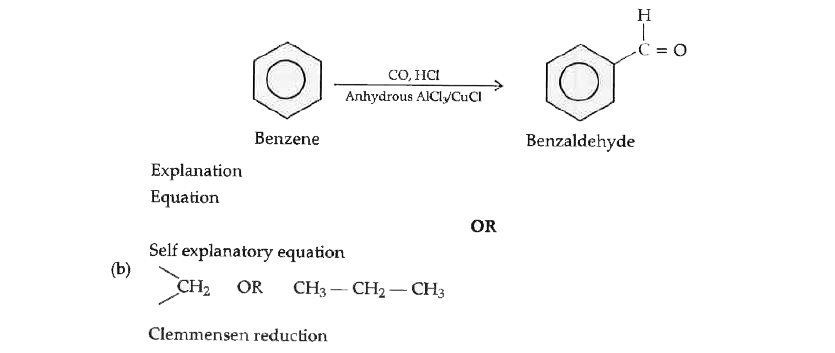 (C) INCREASES. |
|
| 89144. |
(a) How are tetrahedral and octahedral holes formed ? (b) If N is the number of octahedral holes, what will be the number of tetrahedral holes ? |
|
Answer» Solution :(a) A tetrahedral hole is FORMED when a sphere of the second layer is above the void of the first layer. An OCTAHEDRAL void is formed when the triangular VOIDS in the second layer are above the triangular voids in the first layer and the triangular shapes of these do not overlap. (B) If N is the number of octahedral HOLES (voids), the number of tetrahedral holes will be 2N. |
|
| 89145. |
(A) Lactic acid shows geometrical isomerism. (R) It has a C=C double bond. (R) It has a C=C double bond. |
|
Answer» |
|
| 89146. |
(a) How are tetrahedral and octahedral holes created ? (b) Is there any difference between cubic closed packed and face-centred cubic structure ? What is the other notation for such structures ? (c) Which type of substances show Schottky defect ? Give two examples of substances showing this defect. |
|
Answer» Solution :(a) When a sphere in the second layer is above the voids in the FIRST layer, a TETRAHEDRAL hole is CREATED. When the triangular void in the second layer is above the triangular void in the first layer, an octahedral void is created. (b) There is no difference between cubic closed packed and face-centred cubic STRUCTURES. These are also represented as ABCABC... structures. (c) Ionic substances show Schottky defect. NaCl and KCl are EXAMPLES of substances with this defect. |
|
| 89147. |
A laboratory reagent imparts green colour to the flame. On heating with solidK_(2)Cr_(2)O_(7)and conc. H_(2)SO_(4) it evolvesa redgas. Identifythe regent . |
|
Answer» `CaCl_(2)` |
|
| 89148. |
How are primary amines prepared from nitro compounds? Write the equation. |
|
Answer» Solution :Nitro compounds are REDUCED to amines by passing HYDROGEN gas in the presence of finely divided nickel, PALLADIUM (or) platinum. `underset("Nitro compound")(R-NO_(2))overset(H_(2)//Ni)rarr underset(1^(@)" Amines")(R-NH_(2))` |
|
| 89149. |
A house wife while working in the kitchen get a cut on the finger. It started bleeding and become panic. She immediately called her neighbour. She had kept ferric chloride in her house. She immediately applied it on the affected area and the bleeding stopped. (i) What is the chemical formula of ferric chloride ? (ii) Why did bleeding stop on applying it on the affected finger? (iii) What is the name of the phenomenon involved ? (iv) What is the value associated with this from the point of view of chemist? |
|
Answer» Solution :(i) CHEMICAL formula of ferric CHLORIDE is `FeCl_3` (ii)` Fe^(3+)` ions of `FeCl_3` neutralize the charge on the colloidal particles of blood. This leads to coagulation of blood. Bleeding THEREFORE, stopped. (iii) This phenomenon is known as coagulation or flocculation (iv) All house wives must keep small bag or kit in their KITCHEN. It must have ferric chloride kept in small bottle or potash alum, burnol and bandages etc. Minor accidents are very common in kitchen. The kit can be very helpful to deal with emergency. |
|
| 89150. |
A lab assistant prepared a solution by adding a calculated quantity of HCl gas 25^@C to get a solution with [H_3O^+]=4 times 10^-5M. Is the solution neutral (or) acidic (or) basic. |
|
Answer» SOLUTION :`[H_3O^+]=4 TIMES 10^-5 M` `pH=-log_10[H_3O^+]` `pH=-log_10[4 times 10^-5]` `pH=-log_10[4]-log_10[10^-5]` `pH=-0.6020-(-5)=-0.6020+5` `pH=4.398` |
|